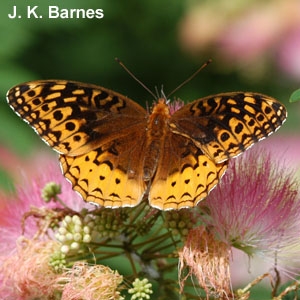Great spangled fritillary
Order: Lepidoptera
Family: Nymphalidae
Genus and species: Speyeria cybele (Fabricius)
The fritillaries are a subgroup of the brushfooted butterflies, family Nymphalidae. The silvered fritillaries, genus Speyeria, comprise 14 New World species. Wings of most species have a complex pattern of orange and black on top with distinctive silver spots on the underside. Adults are often found feeding at high quality nectar sources, such as milkweed, mint, and thistle flowers. Caterpillars of all species feed on Viola. Some Speyeria females lay eggs on twigs, stones and other objects near green violets, but the species from dry habitats seem to delay laying most of their eggs until late summer, when they oviposit in places where the violets have dried up for the year. Winter is spent as an unfed, first instar larva. Pupation takes place inside a simple tent made with strands of silk stretched between surrounding surfaces. Caterpillars are secretive, nocturnal ground dwellers. All species have a single generation per year.
The great spangled fritillary is the most common fritillary in the eastern United States. It has a wingspan of up to 4 inches. Adults fly from late spring to late summer. Females may lay eggs in late spring to early summer, but they often delay until late summer. Adults sip flower nectar and occasionally feed on dung. Some female great spangled fritillaries are black. Males patrol all day in search of females.
Less common Arkansas fritillaries include the Diana fritillary and the regal fritillary. The Diana displays extreme sexual dimorphism. Males are dark brown with a broad orange outer margin. Females are black and blue mimics of the distasteful pipevine swallowtail. Once thought to be imperiled, it is now known to be uncommon to locally common in areas scattered throughout the Interior Highlands and northern Coastal Plain. Regal fritillary caterpillars feed on bird’s-foot violet. This species might still be found northwest Arkansas, but it is thought to be disappearing or declining over most of its range.

